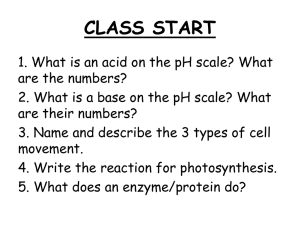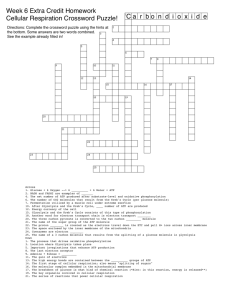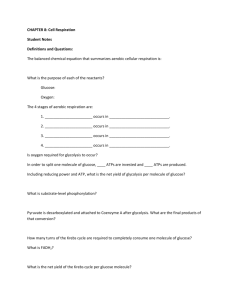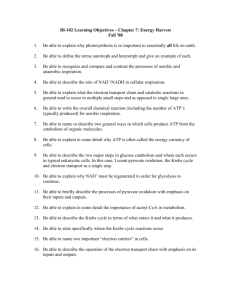Slide 1 - MisterSyracuse.com
advertisement
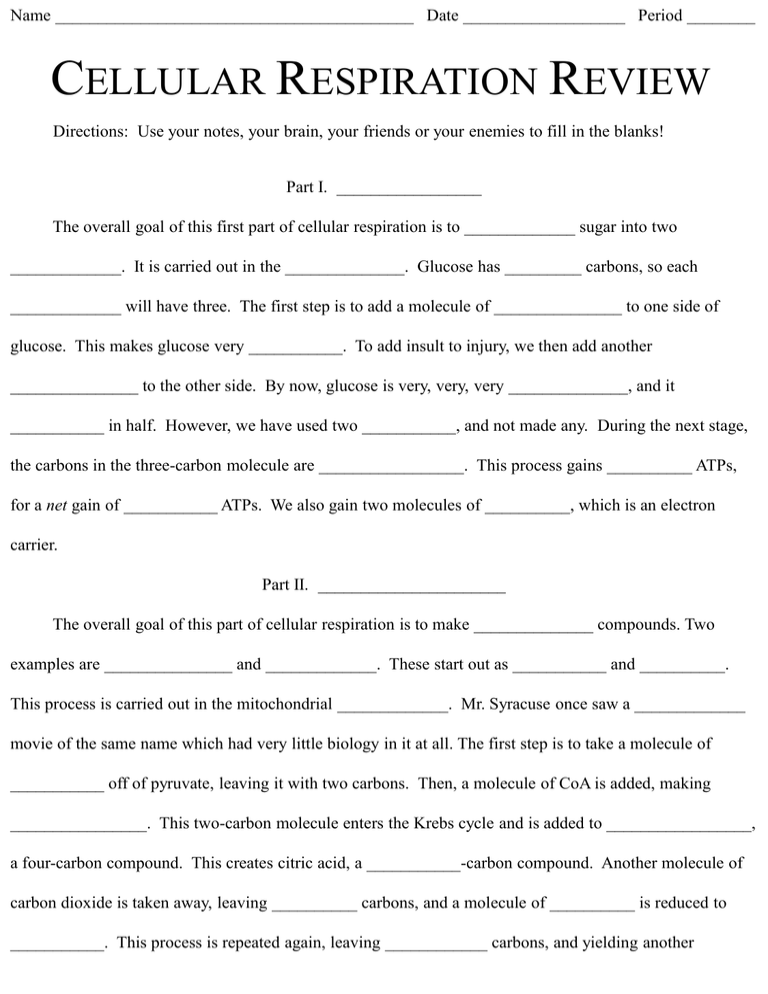
Name __________________________________________ Date ___________________ Period ________ CELLULAR RESPIRATION REVIEW Directions: Use your notes, your brain, your friends or your enemies to fill in the blanks! Part I. _________________ The overall goal of this first part of cellular respiration is to _____________ sugar into two _____________. It is carried out in the ______________. Glucose has _________ carbons, so each _____________ will have three. The first step is to add a molecule of _______________ to one side of glucose. This makes glucose very ___________. To add insult to injury, we then add another _______________ to the other side. By now, glucose is very, very, very ______________, and it ___________ in half. However, we have used two ___________, and not made any. During the next stage, the carbons in the three-carbon molecule are _________________. This process gains __________ ATPs, for a net gain of ___________ ATPs. We also gain two molecules of __________, which is an electron carrier. Part II. ______________________ The overall goal of this part of cellular respiration is to make ______________ compounds. Two examples are _______________ and _____________. These start out as ___________ and __________. This process is carried out in the mitochondrial _____________. Mr. Syracuse once saw a _____________ movie of the same name which had very little biology in it at all. The first step is to take a molecule of ___________ off of pyruvate, leaving it with two carbons. Then, a molecule of CoA is added, making ________________. This two-carbon molecule enters the Krebs cycle and is added to _________________, a four-carbon compound. This creates citric acid, a ___________-carbon compound. Another molecule of carbon dioxide is taken away, leaving __________ carbons, and a molecule of __________ is reduced to ___________. This process is repeated again, leaving ____________ carbons, and yielding another ____________. Next, a molecule of ADP is phosphorylated to _________. We rearrange this four-carbon compound to reduced yet another molecule of _________ to ___________. Lastly, one more rearrangement reduces this electron carrier (a different one!) ____________ to __________. At last, we have regenerated _________________, the four-carbon compound to which we add acetyl CoA. This is necessary if we want the ____________ to continue. The Krebs cycle must turn ________ times per glucose, because each glucose yields ___________ pyruvates. Part III. ______________________________ The goal of this part of respiration is to make copious amounts of ____________. This part of respiration takes place right on the inner ___________________. The way we make this ATP is by making a _______________ gradient. The electron carriers (_________ and ___________) drop off their electrons at the first protein of the ETC. The next protein in line is more ___________________, meaning it likes electrons more, so it steals the electron from the first protein. This causes a ______________ to be pumped into the ___________________________. The next protein is even more __________________, so it steals the electron, pumping another proton across. The final protein needs a place to drop off its electron, but there are no more proteins! So, _______________ acts as the final electron acceptor. It then combines with hydrogen to make _____________. So far, no ATP has been made, though. We have made a gradient of _____________, however. Just like a waterfall, these protons go from an area of ____________ concentration to ____________ concentration. The only way for them to get there, however, is through an enzyme called ______________________. They go through this enzyme, which spins, and slaps a ________________ onto ADP to make ___________. This makes all the ATP that you could ever want!

